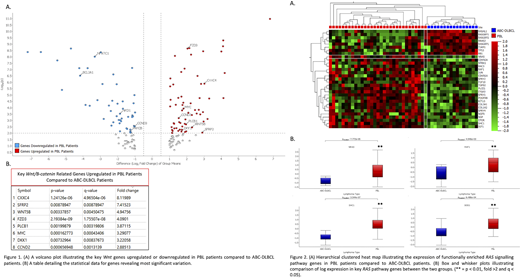Background:Plasmablastic lymphoma (PBL), is a rare aggressive B-cell lymphoma that shares many overlapping characteristics with activated B-cell type diffuse large B-cell lymphoma (ABC-DLBCL) and multiple myeloma (MM). High expression ofWnt/β-cateninpathway molecules has been linked with several aspects of tumour biology in ABC-DLBCL and MM. In MMWnt/β-cateninplay critical role in chemoresistance, while high FOXP1 in ABC-DLBCL exert poor prognosis through up-regulation of theWnt/β-cateninsignalling pathway. There is strong evidence that enhanced crosstalk between the Wnt/β-catenin andRASpathways impact tumorigenesis and metastasis of cancerous stem cells in various cancers. In breast cancer; targeting theWnt/β-cateninand RAS pathways with small molecular inhibitors have shown effective results. The role of the Wnt/β-catenin signalling pathway and its corresponding linkage toRASsignalling molecules remained unknown in PBL. This pilot study provides preliminary data in relation to expressionof Wnt/β-cateninandRASpathways molecules in PBL in contrast to ABC-DLBCL.
Method:FFPE RNA from diagnostic tissue samples in PBL patients (n=31) were compared with ABC-DLBCLs (n=18) patients for keyWnt/β-cateninandRASpathway molecules expression, utilizing nCounter (NanoString Technologies) platform. Qlucore Omics Explorer software was employed with defined criteria (fold change >2.0; p<0.01 and q <0.05) for statistical analysis. Gene Set Enrichment Analysis (GSEA) from 5 publicly available gene data sets was used to analyze the expression of other accompanying pathways.
Result:We identified significant differential expression of mRNA related toWnt/β-cateninsignalling between ABC-DLBCL and PBL (Figure 1). Expression ofWnt/β-cateninsignalling inhibitors (CXXC4, SFRP2, and DKK1) were significantly higher among PBL compared to ABC-DLBCL (8.12-3.22 log fold difference). In divergence, molecules linked withWnt/β-cateninsignalling activation were elevated in PBL when compared to ABC-DLBCL (FZD3andWNT10B). The GESA analysis proved that the RAS pathway was significantly up-regulated in PBL patients compared to ABC-DLBCL. In particular, the expression of crucial RAS pathway genes such asNRAS, RAF1, SHC1, andSOS1was significantly up-regulated in PBL patients when compared to ABC-DLBCL patients (Figure 2).
Conclusion:Our data suggest that the expression ofWnt/B-catenintarget genes and ligands are enhanced in PBL patients along with the up-regulation of theRASsignalling pathway molecules as compared to ABC-DLBCL. The heightened expression of crucialWnt/B-catenininhibitors does not down-regulate the Wnt/β-catenin signalling. We anticipate that the combined down-regulation of theWnt/ β-cateninandRASpathways by targeting its key members (RAF1, NRAS, FZD3) may serve to contain tumor progression in PBL, hence impacting prognosis.
Stewart:Gilead:Honoraria;Sandoz:Honoraria;Teva:Honoraria;Amgen:Honoraria;Celgene:Honoraria;Abbvie:Honoraria;Roche:Honoraria;Janssen:Honoraria;Novartis:Honoraria;AstraZeneca:Honoraria.
Author notes
Asterisk with author names denotes non-ASH members.


